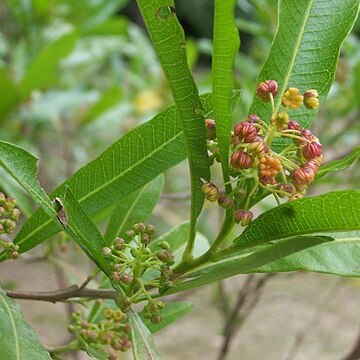Perennial, dioecious, andromonoecious, gynomonoecious, polygamodioecious, polygamous or (some former Distichostemon species) monoecious shrubs or small trees, often viscid. Leaves alternate, rarely opposite (D. ericoides), simple or pinnate, glabrous to hairy, rarely with glandular hairs (D. glandulosa). Inflorescence cymose, female flowers sometimes solitary. Flowers actinomorphic, inconspicuous. Sepals 3–7 (or 5–10 in former Distichostemon species), free, caducous or persistent. Petals absent. Stamens 6–16 (or 8–74 and usually in 2 to many irregular rows in former Distichostemon species), in female flowers absent or rudimentary. Disc small. Ovary 2–6-carpellate (3–8-lobed, 3–8-locular in former Distichostemon species), with 2 ovules per locule, glabrous or pubescent, usually viscid; in male flowers rudimentary or absent. Capsule 2–6-angled or 2–6-winged, membranous, coriaceous or crustaceous; the dorsal face of each carpel usually extended into a wing or appendage. Seeds arillate or exarillate; testa covered with hyaline membrane usually fused to testa, sometimes free like an envelope or partially free at margin.
Shrubs or small trees, evergreen, sometimes with a glandular resinous exudate on leaves and inflorescences. Leaves simple or pinnate, estipulate. Flowers bisexual or unisexual and plants dioecious, actinomorphic, solitary and axillary or arranged in terminal and axillary racemes, corymbs or panicles. Sepals (3-)5(-7), valvate or sometimes imbricate, deciduous when mature. Petals absent. Disk inconspicuous, absent in male flowers. Stamens (male flowers) 5-8; filaments short; anthers ellipsoid, obtusely 4-gonous, connectives prominent. Ovary (female flowers) ellipsoid, obcordiform, or transversely ellipsoid, 2-or 3(or 5 or 6)-gonous, 2-or 3(or 5 or 6)-loculed; ovules 2 per locule, one ascending, and one pendulous; style apical, much longer than ovary, often twisted, deciduous; stigma 2-6-lobed. Capsules samaralike, 2-or 3(-6)-loculed, septifragal, boatlike. Seeds 1 or 2 per locule, obovoid, lenslike, or subglobose; testa crustaceous, arillode present or absent; hilum thick; embryo revolute, cotyledons linear. 2n = 28, 30, 32.
Small evergreen trees or shrubs, sometimes ericoid, with simple or compound leaves, sometimes with conspicuous glandular varnish. Flowers regular, bisexual or unisexual, individual plants bearing one or more types of flower; sepals 3–4(–7), valvate or imbricate, free (in Africa) or coherent at the base, deciduous or persistent; petals absent. Stamens 5–8(–10), inserted into the outer surface of the circular disk; filaments glabrous, much shorter than the anthers; anthers oblong, sagittate at the base. Ovary rounded or lobed, 2–4(–6)-locular, each locule with 2 ovules; style as long as to much longer than the ovary; ovary rudiment in the male flower minute. Fruit a papery capsule, often winged, dehiscent by splitting along 2–3 central septa. Seeds 1(–2) per valve, black, globose or lenticular, without an aril.
Shrubs or small trees. Leaves alternate, simple or pinnate; stipules absent. Thyrses terminal or lateral, solitary, racemose, corymbose or paniculate. Flowers unisexual or polygamo-dioecious; sepals 2-5, imbricate or valvate; petals absent; disc obsolete in the staminate flowers, small in the pistillate flowers; stamens 5-8, the filaments short, the anthers linear-oblong, obtusely tetragonous; style 3-to 6-parted, the ovules 2 in each cell. Fruits membranous or coriaceous capsules, 2-to 6-angled, the cells 1-or 2-seeded, the angles acute, obtuse or broadly winged; seeds obovoid, subglobose or lenticular, lacking an aril, the testa crustaceous or coriaceous; embryo circinate.
Shrubs. Young branches slightly ribbed. Leaves alternate, simple, petiolate or sessile; stipules wanting. Inflorescences axillary or distal panicles with determinate growth, the flowers solitary or variously clustered along the rachis. Flowers unisexual or bisexual (plants dioecious or polygamous-dioecious). Calyx of (3)-5-(7) sepals; petals wanting; disc wanting or intrastaminal in pistillate flowers. Stamens usually twice as many as the sepals; filaments short; anthers sagittate or oblong; ovary of (2)3-5(6) carpels, each with 2 ovules. Capsules winged, thin walled. Seeds usually black, lenticular or subspherical, not arillate; embryo with both cotyledons spirally coiled.
Fls unisexual to polygamous, us. in racemes or panicles. Sepals 2-5; petals 0; stamens (5)-8-(10). Ovary 3-6-celled, ovules 2 per cell. Capsule 2-6-sided, septicidally dehiscent, valves winged. Seeds 1-2 per cell, compressed; funicle thickened, embryo spirally coiled. Shrubs or trees, often viscid. Some 50 spp., mainly Australian, with scattered members in tropics and subtropics.
Ovary 2–4(5–6)-gonous, 2–4(5–6)-locular; loculi 2-ovulate; style often contorted, 2–6-fid.
Leaves usually simple (rarely paripinnate), usually resinous and viscid.
Stamens 5–8, absent or sterile in female flowers; filaments very short.
Seeds 2 in each loculus (or 1 by abortion); arillode absent.
Flowers actinomorphic, dioecious (rarely bisexual).
Sepals 3–7, sometimes slightly connate at the base.
Inflorescence a racemoid or paniculate thyrse.
Trees, shrubs or shrublets, often ericoid.
Fruit a 2–6-locular capsule, often winged.
Disk vestigial.
Petals 0.

